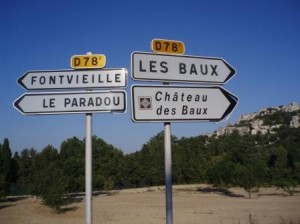
Les Baux-de-Provence is a popular summer destination in France
It’s the time of les grandes vacances (big summer vacations) in France. Consequently, planes and trains are crowded with travelers headed to French holiday locales. And automobiles are packing the highways and byways all over the country.
This past Saturday was particularly crazy for drivers headed south on the autoroute (French super highway) towards Provence and the Mediterranean coast. As my husband and I drove north from Avignon towards Lyon after some nice time off in la Provence, we saw that the southbound traffic was bumper to bumper for more than 200 kilometers. That’s right, the A7 highway was virtually a parking lot for over 120 miles. For these poor motorists, a journey that would have normally taken two hours ended up being an all-day affair.
Truth be told, this is not an unusual occurrence. The first weekend in August is always insane on French roadways, so much so that the French traffic authority forbids heavy trucks from using the autoroutes that Saturday in an effort to alleviate traffic congestion. In addition, many holiday rental properties schedule their weekly changeover on Saturdays. And last but not least, it seems that the French accept these infernal driving conditions in their haste to go on vacation. Years ago, I made a decision never to drive on the heaviest French travel days – at least not in the same direction as everyone else!
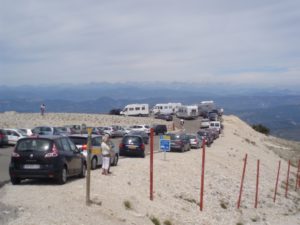
Summer holiday traffic & precarious parking at the top of Mont Ventoux in Provence
Normally, however, driving in France is a breeze and even a pleasure. While trains are great for going longer distances, a car is the best way to see France’s beautiful countryside and charming villages up close. It also gives you the freedom to stop and see anything that looks interesting. And there is plenty of ‘interesting’ in France. So in the spirit of a great French driving experience, here are some things to keep in mind when venturing forth on French roads:
Cars: As in the U.S., driving is on the right side of the road. Car rental agencies offer everything from tiny compact cars to vans to luxury vehicles so you have your choice of transport. Manual or standard cars are the norm in Europe – if you need an automatic, do specify this feature when reserving and be prepared to pay a bit more for it. You’ll want to reserve your car in advance as hot destinations often run out of options – and cars! – during peak times of the year. You can often get better rental rates in advance as well. Do check the opening hours of your car rental agency as some offices close for lunch and/or on Sundays. Seatbelts are mandatory for everyone in vehicles, and car seats or booster seats are required for children under the age of 10. And it is illegal for drivers to use cell phones while driving.
Drivers License: If you’re visiting France (versus living there), your U.S. driver’s license will work fine. Some rental agencies do say they require an International Drivers Permit but in my experience, this has not been the case. Still, the international permits are easy to obtain from AAA or similar agencies in the U.S. They cost about $10 and require proof of a U.S. driver’s license.
Gas: Fuel is extremely expensive in France, about the equivalent of $8 a gallon. Cars run on unleaded – sans plomb – or diesel – gazole. When renting a car, I always pick a diesel-powered engine as diesel is cheaper than unleaded and cars get more mileage on it. Just be sure and have the rental agency write down which essence (gas) your car needs so that you don’t accidently put the wrong type in it. Fuel in France is sold by the liter at gas stations in towns as well as along the autoroutes. The least expensive places to faire le plein (fill up) in France are city supermarket gas stations so keep your eyes peeled for a nice Carrefour or Intermarché along your route. Worth noting is that while French gas stations often do take credit cards at the pump, pump transactions require cards with a microchip which most U.S. cards do not have. So you can fill up and then pay the attendant in cash or with your regular credit card at the booth. But in this situation, you’ll want to avoid needing gas at night or on Sundays when no attendants are on duty.
Speed: Speed limits in France are 130 kilometers per hour (kph) on the highway (a little over 80 miles per hour), 90 kph on other roads not in built-up areas and 50 kph in towns and built-up areas, unless otherwise marked. Speed signs are round with a red border and have the speed limit number prominently displayed in the middle. Often the speed signs will be accompanied by "Rappel," meaning ‘reminder.’ If it is raining, the speed limit on highways automatically decreases to 110 kph. With regard to speeding, you can probably get away with going up to 10 kph over the posted limit. Beyond that, you are likely to be stopped by the police, or more probably, you will get your photo snapped by a speed camera. Contrary to popular belief, French speeding tickets can follow you back to the U.S. And it used to be that signs would warn drivers in France that a speed camera was nearby, but this is not always the case anymore.
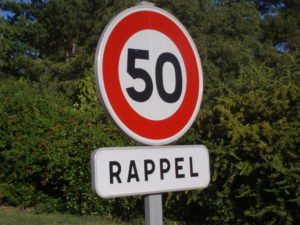
Roads: French highways, or autoroutes, crisscross France and are generally well maintained. Autoroutes are designated by blue signs with the letter A plus a number or numbers. For example, you have the A6 through Burgundy towards Lyon, also nicknamed the "Autoroute du Soleil" since it’s headed to the sunny south of France. French autoroutes are mostly tollroads which are indicated by signs saying "Péage." As you enter the tollroad, you’ll take a ticket. When you get ready to exit the tollroad or when that toll section ends, you’ll come to a toll booth and need to pay for your use of the road. Approaching a toll booth can be tricky; be sure to stay right (away from the tolltag lanes). These are the cash booths which will have either a machine or an attendant. If it’s a machine, you’ll put your ticket in according to the direction of the arrow and wait for the required euro amount to appear on the screen. Next you will put in coins or bills. The machines make change. Do have a fair amount of money on hand if you are going a long distance – I just paid about 60 euros total to go from Cavaillon in southern France up to Mulhouse on the French/German border. If you want a receipt, push the button that says "Reçu" and a paper receipt will appear. There will also be booths that take credit cards but as with gas station pumps, these machines mostly take credit cards with microchips only. You don’t want to enter a credit card line only to find out your credit card doesn’t work – and then have all those (angry) French drivers piled up behind you!
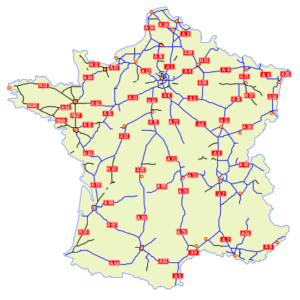
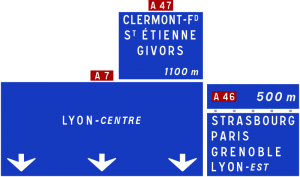
There are two other rules to keep in mind on autoroutes: The far left lane is the ‘fast lane.’ It is used mainly for passing so don’t hang out there or you will for sure have some speedy drivers sounding their klaxons (horns) to have you move out of the way. Also, since the tollroads are limited access, you can go up to 30 kilometers before being able to take a sortie (exit). Therefore, make sure you are headed where you want to go when you get on the autoroute – or it will be a while before you can turn around and go the other way.
Roundabouts: France has loads of ronds-points, i.e. roundabouts or traffic circles, all over the country. The most famous one of course is the Place de l’Etoile in Paris with the Arc de Triomphe in the center. (If you’ve never done this, it is loads of fun – just be prepared for one crazy ride!) The great thing about ronds-points is that you don’t have to stop at a traffic light but you do have to play by the rond-point rules. Anyone already in the roundabout has the right of way so you’ll want to get out in the circle as fast as you can. Just wait for a space and then jump in. The other good thing about them is that if you are not sure which direction to take, you can keep going around the rond-point until you figure out which exit is yours.
Traffic lights: French traffic lights use generally the same signalization as in the U.S. A red light – feu rouge – means stop and a green light – feu vert – means go. In France, however, the yellow light blinks after the red light finishes its turn to indicate that the green light is about to come on, the opposite pattern of American traffic lights. Do note that turning right on a red light is not the practice in France.
Road Signs: French road signs are fairly self explanatory. After all, the illustrations do most of the communicating. Interestingly, stop signs in France say "STOP" so U.S. drivers will feel especially at home with that one. A couple that are worth making sure you know are "Do Not Enter" which is a red circle with a white horizontal line across the middle (see the fifth column, third row down below). Also important is "No Parking" which is a red circle around a dark blue center with a red diagonal line through it (see the third column, fifth row down below).
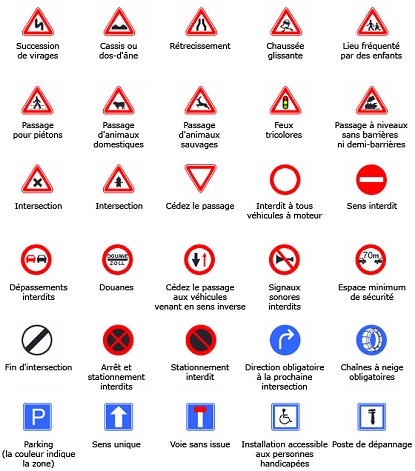
Parking: Speaking of parking, space is at a premium in France so most often you will have to pay to park. On public streets or in parking lots and garages in towns and cities (although Paris is a whole other story), you will likely see signs that say "Stationnement payant" or on the ground in the parking spaces it will say "Payant." This means you need to look for a parking meter – the French don’t put a meter at each parking place – somewhere nearby. If in doubt, look on the dashboard of cars near you to see if they have a paper ticket sitting there. When you find the parking meter machine, or horodateur in French, you can decide how much time you need and put the right amount of cash in accordingly. Then you take the ticket and put it on your dashboard with the time and amount displayed clearly. Often, there will be times that are free depending on the location – for example, lunchtime from 12 to 2pm in Arles is free. Or Sundays and holidays are free and so on. The further you get out of towns or villages, the more likely parking is to be free. One thing to note about parking in towns: Parking can be free or payant all week except when it comes to market day. Then all of a sudden, it’s interdit (forbidden) for the duration of the open-air market. And finally, you will always need to make sure not to park in front of someone’s driveway in France. Since French garage doors can blend in or look pretty picturesque, driveways can be easy to overlook. If anything says "Ne pas stationner," you’ll want to avoid that spot.
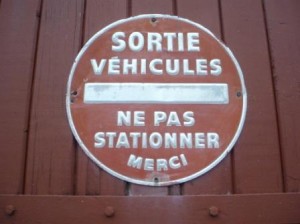
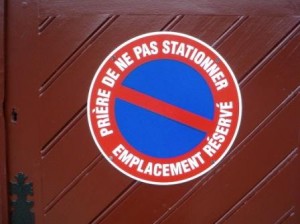
Emergencies: If you have an emergency or accident on the road in France, the French police, fire and ambulance services can be reached at 112 (U.S. equivalent of 911). If there is any injury even if it is not your fault, you must remain at the scene until the police arrive. When you car is stalled due to an accident or mechanical problem, you must alert other drivers by putting the warning triangle (provided in your car) on the road some distance behind your vehicle. You can also put on the fluorescent jacket that comes with your car. For any mechanical issues with your rental car, you’ll want to keep the rental agency’s emergency number handy. In my experience, they are usually very responsive and help get your problems resolved fairly quickly. For a case in point, click here to read a previous article about a car break-down I had in France a few summers ago.
Maps and GPS: I always take a load of Michelin maps with me when driving in France. They are very straightforward, often detailed and help navigate everything from winding back roads to medieval streets in small towns. You can also get a GPS with your rental car these days and usually a GPS can help you find even hard-to-locate destinations. If you have your cell phone with you, Google maps can be handy for finding your location. Do study your route ahead of time and take any route advice from Google with a grain of salt, however, as it does not always provide the most direct or logical path to one’s destination.
Again, driving in France is usually a wonderfully pleasurable experience, especially the further out you get from large cities. With a good destination, a good rental agreement, a good map/GPS and hopefully good weather, you will be all set for a great travel adventure. So cheers to driving in France – and bonne route!